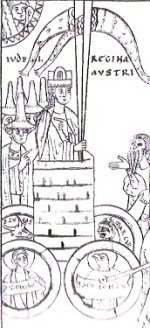kwaw
DoctorArcanus said:In the ivory described by Eguchi Koretaka at least three of the four virtues appear together with the tetramorph. I wonder if there also was an early connection between the symbols of the Evangelists and the Cardinal Virtues....
Marco
In the Vivian Bible [c.845-846, a gift from Abbot Vivian and the monks of the Abbey of Saint-Menard to king and holy roman emperor Charles 1, the Bald, currently in the Bibliotheque Nationale] there is a picture of King David [remembering here the connection between Adam = A[dam], D[avid] and M[essiah]], in a Mandorla [with the inscription above his head DavidRexEtProp = 'David king and prophet'] and in the four corners allegories of the four cardinal virtues. There is another picture in the same bible of 'Majestas Domini' suggesting in mutual symbolism a clear connection between the two [maybe with David interpreted as a prefigurement]. I have a copy of the King David in mandorla with corner virtues, it is rather large but if anyone is interested I will have a go at scanning it and finding somewhere to post it so you can have a look.
It is also published on p.96 of Masterpieces of Illumination by Taschen, 2005. {Highly recommended, a bargain at a special price of just £14.95 to celebrate their 25th anniversary, withy a few illustrations that parallel Tarot iconography}.
Kwaw


